I generated 1,000,000 random number draws using the random module
import random
liste = []
for i in range(0, 1000000):
liste.append(random.uniform(0,1))
Now I have to store the values obtained in a histogram at 6 bins using the bins option. And using if/else conditions on the list items, write a algorithm to simulate the result of 1,000,000 dice rolls. Then I have to calculate the frequency of occurrence of each value and compare it to the expected probability p = 1/6.
Does anyone know how to do this please I have no idea...
Thanks in advance!
edit: concerning the bins options
they talk about this :
import matplotlib.pyplot as plt
import numpy as np
# Création de la figure et des axes
fig, axs = plt.subplots(1, 1, sharey=True, tight_layout=True)
# Ajout de l'histogramme
axs.hist(valeurs, bins=np.arange(0.5, 7.5, 1), ec="black")
axs.set_title("Résultats jet dé")
axs.set_xlabel("Valeur dé")
After using @Roland_Smith's program it gives me this
#import random
#liste = []
#for i in range(0, 1000000):
# liste.append(random.uniform(0,1))
import random
liste = random.choices((1,2,3,4,5,6), k=1000000)
import collections
c = collections.Counter(liste)
print(c)
p = [j/1e6 for j in c.values()]
print(p)
import matplotlib.pyplot as plt
import numpy as np
# Création de la figure et des axes
fig, axs = plt.subplots(1, 1, sharey=True, tight_layout=True)
# Ajout de l'histogramme
axs.hist(c, bins=np.arange(0.5, 7.5, 1), ec="black")
axs.set_title("Résultats jet dé")
axs.set_xlabel("Valeur dé")
but the problem is that my histogram looks like this

is it normal because each number has the same probability of appearing or is it not normal?
edit for tdy
import matplotlib.pyplot as plt
import numpy as np
# Création de la figure et des axes
fig, axs = plt.subplots(1, 1, sharey=True, tight_layout=True)
# Ajout de l'histogramme
axs.hist(c,ec="black")
axs.set_title("Résultats jet dé")
axs.set_xlabel("Valeur dé")
edit after help for @JohanC
#import random
#liste = []
#for i in range(0, 1000000):
# liste.append(random.uniform(0,1))
import random
liste = random.choices((1,2,3,4,5,6), k=1000000)
import collections
c = collections.Counter(liste)
print(c)
p = [j/1e6 for j in c.values()]
print(p)
import matplotlib.pyplot as plt
import numpy as np
plt.bar(c.keys(), c.values())
# Création de la figure et des axes
#fig, axs = plt.subplots(1, 1, sharey=True, tight_layout=True)
# Ajout de l'histogramme
#axs.hist(c,ec="black")
#axs.set_title("Résultats jet dé")
#axs.set_xlabel("Valeur dé")
i get a value of 160000 for each dice face, i.e. 6. but 6*160000+960000 i shouldn't get the number of rolls, i.e. 1000000?



